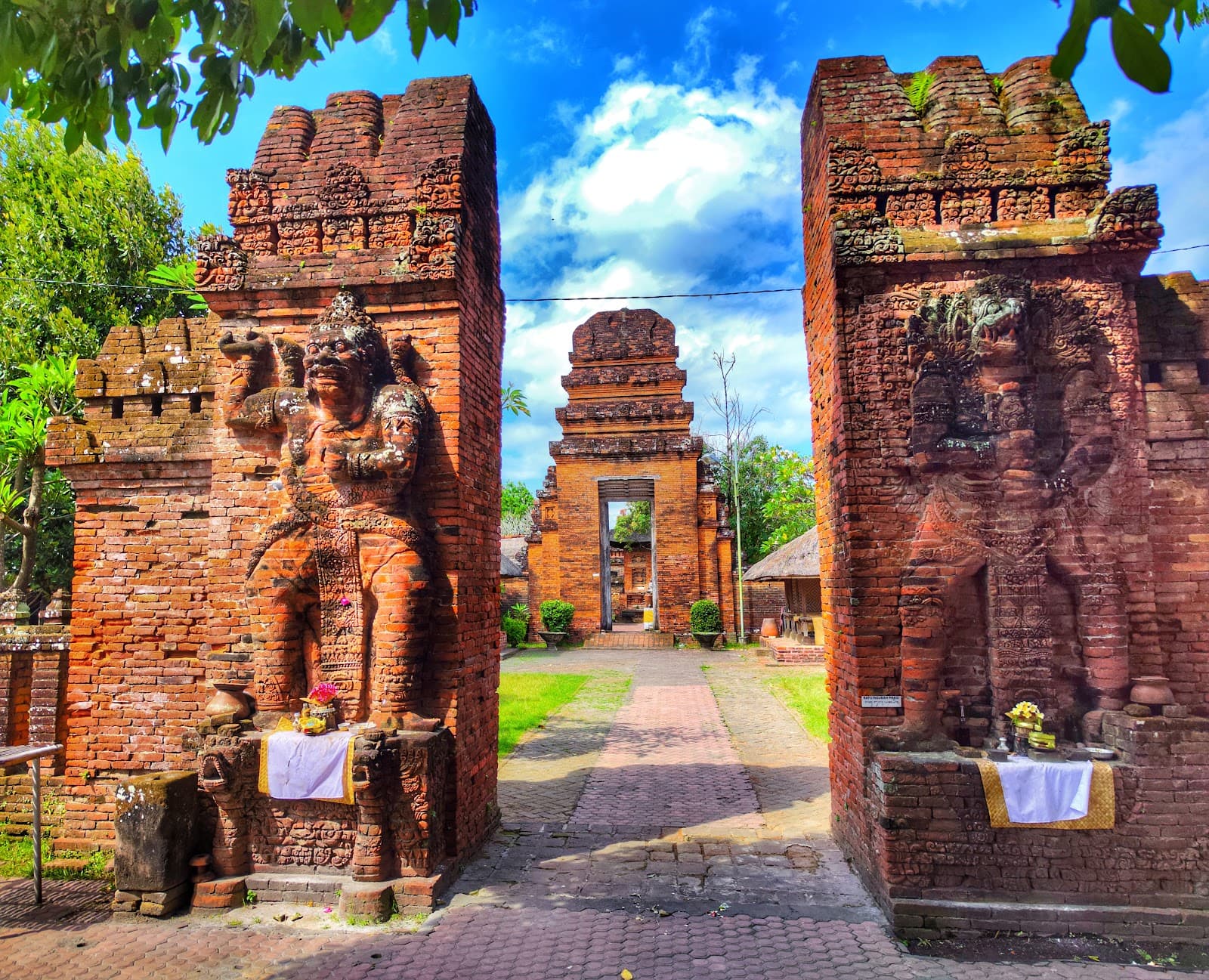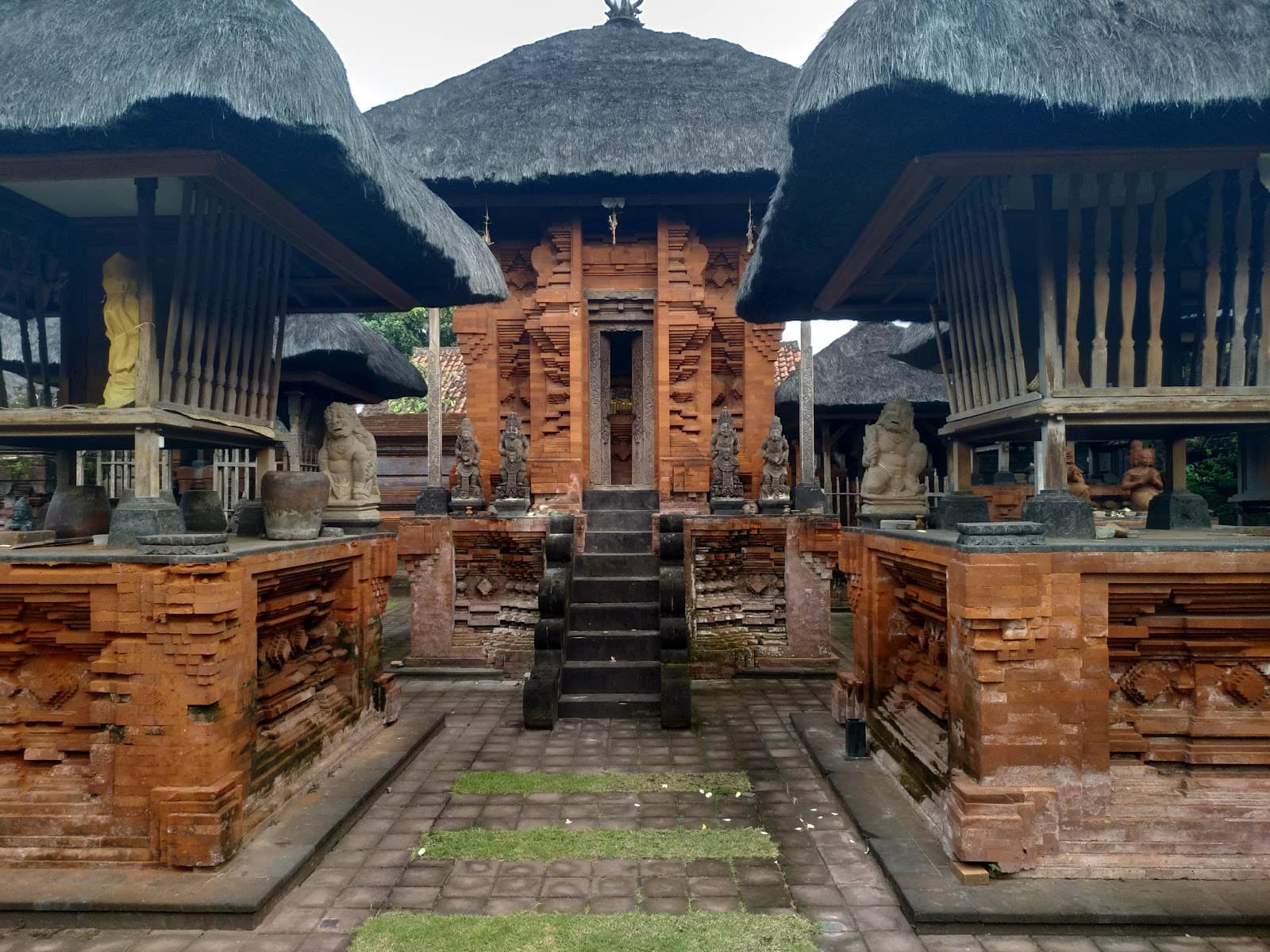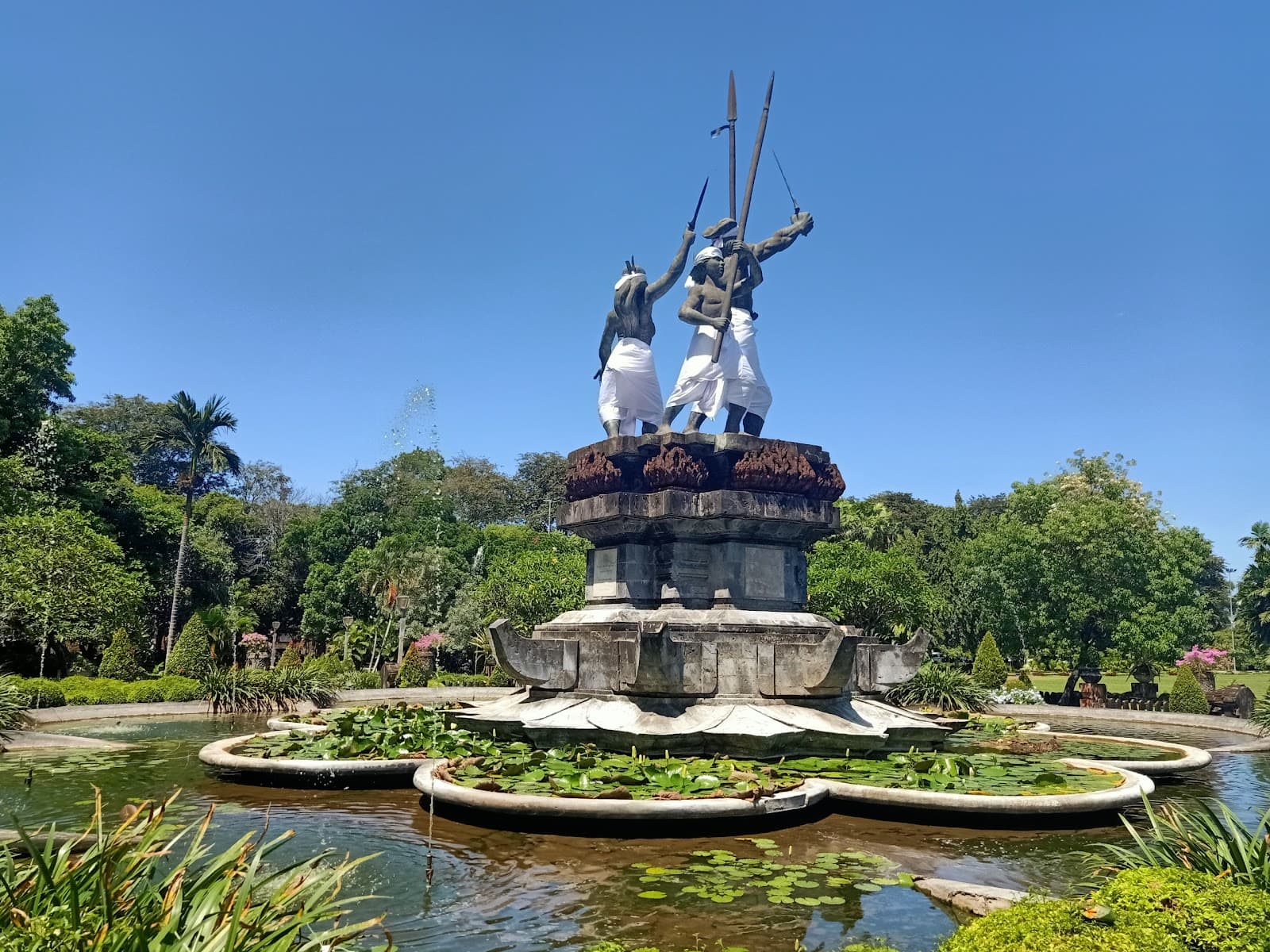
Pura Maospahit
An ancient red brick temple in Denpasar, Pura Maospahit offers a glimpse into Bali's Majapahit heritage with unique architecture and a serene atmosphe...

Highlights
Must-see attractions

Social
From TikTok & Reddit
Best Time
Peaceful and less crowded

Pura Maospahit
Best Time
Peaceful and less crowded

Highlights
Must-see attractions
An ancient red brick temple in Denpasar, Pura Maospahit offers a glimpse into Bali's Majapahit heritage with unique architecture and a serene atmosphere.
"A historical gem with unique terracotta architecture, offering a peaceful glimpse into Bali's Majapahit past."

Modest Dress Required
Wear a sarong and sash to cover shoulders and knees. Rentals may be available. :abaya:
No Entrance Fee
Enjoy this historical site without an entrance fee. Donations are appreciated. :moneywithwings:

Highlights
Discover the most iconic attractions and experiences

Ancient Red Brick Architecture
Temple grounds
Marvel at the unique terracotta brickwork, reminiscent of Majapahit era temples. A true architectural wonder.

Panca Mandala Concept
Temple layout
Experience a temple built with a rare Panca Mandala layout, centering the most sacred area.

Historical Significance
Temple grounds
Connect with centuries of history, from its founding by Kebo Iwa to its Majapahit connections.
Plans like a pro.
Thinks like you
Planning Your Visit
Respectful Attire is Key
Timing Your Visit for Serenity
Best Times
Insider Tips
from TikTok, Instagram & Reddit
Modest Dress Required
Wear a sarong and sash to cover shoulders and knees. Rentals may be available. :abaya:
No Entrance Fee
Enjoy this historical site without an entrance fee. Donations are appreciated. :moneywithwings:
Quiet & Calm Atmosphere
Visit early or late for a serene experience. It's a small, peaceful temple. :clock1:
Scan for Info
QR codes with English information are available for self-guided exploration. :iphone:
Tips
from all over the internet
Modest Dress Required
Wear a sarong and sash to cover shoulders and knees. Rentals may be available. :abaya:
No Entrance Fee
Enjoy this historical site without an entrance fee. Donations are appreciated. :moneywithwings:
Quiet & Calm Atmosphere
Visit early or late for a serene experience. It's a small, peaceful temple. :clock1:
Scan for Info
QR codes with English information are available for self-guided exploration. :iphone:
Respectful Behavior
Be mindful of local customs and avoid disturbing the sacred atmosphere. :pray:
What Travellers Say
Reviews Summary
Pura Maospahit is praised for its unique, ancient red brick architecture and historical significance, offering a peaceful and free cultural experience. While small, its historical depth and serene atmosphere are highly valued by visitors seeking an authentic glimpse into Bali's past and its connection to the Majapahit Empire.
"Still an original temple in Denpasar. No entrance fee. It's simple, but that is the charm. Takes 30 minutes or less to see."
Govert van Ginkel
"Formerly dubbed as the "Terracotta Palace" shrine & temple, of which mentioned in my 2023 novel work, due to it's uniquely architecture is completely built from bare red bricks lack of mortar, reminiscent of the ancient Candi temples of Majapahit empire legacy from Trowulan, East Java.
This ancient heritage temple which was located in the heart of bustling Denpasar city, at least wrote down it's historical story for almost 8 centuries at Bali island, since the golden age of Majapahit empire.
The first establishment of this heritage temple was conducted by a legendary Balinese hero known as: Kebo Iwa in 13th century, of which its historical record was written in an ancient Balinese inscription called: Babab Wongayah Dalem.
This temple is considered as the one & only ancient Balinese temple of which the temple's shrines order doesn't following the standard order of mainstream Balinese Pura temples around Bali island. Instead of the order of temple's edifices following the order of ancient Javanese palace and temples from Java island.
Since the first establishment in 12th century, Kebo Iwa only built a single Candi temple without its companion shrines. But after the assassination of Kebo Iwa himself committed by Gajah Mada, the royal vicegerent of Majapahit empire who was the great rival of Kebo Iwa himself, as the aftermath Gajah Mada decided to expand the Candi temple into a temple complex by adding shrines and additional edifices, as a truce gesture and to honor Kebo Iwa's death.
During the reign of Badung kingdom several centuries next, a royal architect of the kingdom known as: I Pasek was given order from the king to build another new Candi temple after the first one. I Pasek then visited East Java to studying the temple's architectural design before he built another new Candi temple of which located just by right side of the prior Candi temple. The final completion of this temple complex was dated 16th century.
Even after many centuries next, this temple become the most esteemed holy places I honored the most after the Buddhist monasteries & Chinese folk belief temples. This temple at least allowed me to write my own life's story when I'm trying to establish my better new life at Bali island. Usually I have to pay homage by bringing offerings & incenses for the deities in the temple's inner sanctum, before I pray modestly & make wishes against the deities in the temple's inner sanctum.
Because of my instinctively protectiveness against any sacred places of which held my honor and homage, I do never encourage any meddlesome & indecent tourists or strangers to desecrate this holy place irresponsibly through impertinent & disgusting manners, which may bother the temple's key master & guardian on site.
If (you) don't know how to behave decent through clothing or behavior & pleasing the deities in their temples with homage, at least do never lay down (your) filthy impiety & desecration at there!"
Hardy Li
"The Heritage Hindu Temple that was build in 1200 year. Popular calls as Nusantara's Temple (Pura). Temple stays on side of big streat way to Gajahmada streat Denpasar. Easy to find. The visitors book of Temple is almost from European visitor. They are as tourist or who in research. The architectural is very wonderfull, strong and old terracotta.
Please visit to Pura Maospahit Heritage Denpasar, Bali, Indonesia"
Baptista Indo
What People Like
What People Dislike
Frequently Asked Questions
🚇 🗺️ Getting There
Pura Maospahit is conveniently located on Jalan Sutomo in the Grenceng area of Denpasar, near Jalan Gajah Mada. It's easily accessible by car or taxi. Many visitors find it straightforward to locate due to its position on a main street.
Yes, Pura Maospahit is situated on a main street in Denpasar, making it relatively easy to find. Its historical significance and unique architecture draw visitors seeking cultural experiences.
For exploring Denpasar and its temples, ride-sharing apps like Gojek and Grab are popular and convenient. Renting a scooter is also an option for more independent exploration, but be mindful of Denpasar's traffic.
Pura Maospahit is located in the heart of Denpasar, a bustling city. While not directly next to major tourist attractions, its central location means it's surrounded by the city's urban landscape and local life.
Public transport options in Denpasar are less developed for direct temple access. It's generally recommended to use ride-sharing services or taxis for a more efficient journey to Pura Maospahit.
🎫 🎫 Tickets & Entry
No, there is no entrance fee to visit Pura Maospahit. This ancient temple is open to visitors without charge, though donations are always welcome to help with its upkeep.
Pura Maospahit generally welcomes visitors throughout the day. It's advisable to visit during daylight hours to best appreciate the temple's architecture and surroundings.
No advance booking is required for Pura Maospahit as there is no entrance fee. You can visit spontaneously during daylight hours.
The main restriction is to dress respectfully, covering shoulders and knees. Visitors are also asked to behave in a manner that respects the sacred nature of the site.
Photography is generally allowed, but always be respectful. Avoid intrusive photography, especially if ceremonies are taking place, and ensure your attire is appropriate.
🎫 🏛️ Onsite Experience
The main attraction is its unique architecture, built entirely from red bricks without mortar, reminiscent of Majapahit era temples. The temple's layout, following the Panca Mandala concept, is also a significant draw.
A visit to Pura Maospahit typically takes about 30 minutes or less, as it's a relatively small but historically rich site.
Yes, Pura Maospahit is perfect for a quick stop due to its manageable size and central location. It offers a glimpse into Bali's historical connections with the Majapahit Empire.
Pura Maospahit dates back to the 13th century and is linked to the Majapahit Empire's influence in Bali. It was founded by the legendary Balinese hero Kebo Iwa and later expanded.
While formal guided tours might not be readily available, some locals may offer insights. Additionally, QR codes with information in English are provided for self-guided exploration.
📸 📸 Photography
The distinctive red brick architecture and the unique temple layout offer excellent photographic opportunities. Capture the intricate details of the brickwork and the serene atmosphere.
Photography is generally permitted, but always be respectful. Avoid intrusive shots, especially during any religious activities. Ensure your attire is appropriate for a sacred site.
A standard DSLR or mirrorless camera with a versatile lens will work well. Even a good smartphone camera can capture the beauty of the temple's architecture.
Experiment with different angles to capture the scale of the brick structures and the temple's layout. The entrance and the main shrines offer compelling perspectives.
Early morning or late afternoon provides softer light, ideal for photography. The golden hour can enhance the warm tones of the red bricks.
For Different Travelers
Tailored advice for your travel style
👨👩👧 Families with Kids
To make the visit more engaging for children, consider using the available QR codes for information or preparing a few simple facts about ancient temples and kingdoms beforehand. Emphasize the visual aspect of the old bricks and the idea of a 'palace' from long ago. Remember to ensure everyone is dressed respectfully with sarongs and sashes. :family_amp:
🚶 Solo Travelers & Budget Explorers
Its location in Denpasar makes it convenient to combine with other city explorations. The availability of QR codes for information means you can explore independently and learn at your own pace. The peaceful atmosphere is also ideal for solo contemplation. :person_walking:
🏛️ History Buffs & Culture Enthusiasts
Take your time to absorb the historical narratives, from its founding by Kebo Iwa to its expansion by Majapahit figures. The temple serves as a tangible link to a pivotal period in regional history, providing a profound connection to Bali's past.
Deep Dives
In-depth insights and expert knowledge
The Architectural Marvel of Pura Maospahit
The temple's layout is equally remarkable. Unlike most Balinese temples that orient their most sacred inner sanctum (jero) towards Mount Agung, Pura Maospahit follows the Panca Mandala concept. This ancient Javanese architectural principle places the most sacred area at the center of the temple complex, reflecting a different philosophical approach to sacred space.
This architectural and conceptual distinctiveness makes Pura Maospahit a significant site for understanding the historical and cultural exchanges between Bali and the Majapahit Empire. It's a tangible link to a past era, offering a unique visual and spiritual experience for visitors.
Historical Roots and Majapahit Connections
Following Kebo Iwa's assassination by Gajah Mada, a prominent figure from the Majapahit court, Gajah Mada himself is said to have expanded the temple complex as a gesture of truce and respect. Later, during the reign of the Badung Kingdom, royal architect I Pasek was commissioned to build another Candi temple, further developing the site. The temple complex reached its final form in the 16th century.
This rich historical narrative positions Pura Maospahit not just as a religious site, but as a crucial monument to the historical relationship between Bali and Java, particularly during the Majapahit era. It serves as a testament to the cultural fusion and political dynamics of ancient Indonesia.
Navigating Pura Maospahit: Visitor Insights
Many travelers appreciate that there is no entrance fee, and the temple doesn't aggressively solicit donations, contributing to a more relaxed visit. The availability of QR codes with information in English is also a plus for self-guided exploration, allowing visitors to learn about the temple's history and significance at their own pace.
While the temple is not overly touristy, interactions with locals can be very rewarding. Some visitors have shared heartwarming experiences where locals offered to show them around and explain the temple's details, highlighting the warm hospitality often found in Bali.





Social
from TikTok, Instagram & Reddit